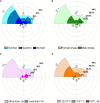Mechanistic understanding of perianth traits hindering pollination in Aristolochia contorta Bunge
- PMID: 37810400
- PMCID: PMC10552756
- DOI: 10.3389/fpls.2023.1226331
Mechanistic understanding of perianth traits hindering pollination in Aristolochia contorta Bunge
Abstract
Insects are vital pollinators for angiosperms, playing a crucial role in their reproductive success and fruit production. Aristolochia contorta is a perennial herbaceous vine that occurs in fragmented populations across East Asia. One notable feature of this plant is its trap flower, which employs a unique mechanism to attract, trap, retain, and release insects, ensuring effective pollination. The presence of this trap flower significantly influences the pollination system of A. contorta. Field surveys and pollination experiments were conducted to understand the processes and effectiveness of its pollination mechanism. It was allogamous and was pollinated by the species from Ceratopogonidae. During the insect attraction stage, 11.57% of the flowers contained insects, primarily Ceratopogonidae spp. Most Ceratopogonidae spp. concentrated in few flowers, indicating that although overall attraction might be modest, specific flowers acted as significant focal points for gathering. Trichomes effectively trapped Ceratopogonidae spp. inside flower tubes. In the retention stage, 26.16% of Ceratopogonidae spp. were loaded with pollen grains, but only 7.91% of those exited the flowers in the release stage. The sticky texture of the perianth's internal cavity posed challenges during this release, leading to adhesion and clogging of the narrow perianth tube. Consequently, a significant portion of Ceratopogonidae spp. became trapped on the perianth wall and perished. This highlights that despite the significant energy and resources invested in flower development, the perianth contributes to the low pollination effectiveness. This study revealed additive factors with negative effects on pollination, including the densely clustered distribution of its pollinators within only a few flowers, insufficient pollen loading onto pollinators, hindered release of entrapped pollinators due to the perianth adhesive surface, and a high rate of defective pollen grains in A. contorta. These factors account for the observed phenomenon of low fruit set (7.7%) and contribute to the diminished rate of sexual reproduction in A. contorta populations. This might lead the species to heavily rely on asexual reproduction, which could potentially lead to gene erosion within populations. The implications of these findings extend to the ecological and conservation aspects, emphasizing the need to understand and conserve the unique pollination system of A. contorta.
Keywords: Aristolochia contorta Bunge; Ceratopogonidae spp.; northern pipevine; perianth function; pollinator; sexual reproduction; trap flower.
Copyright © 2023 Park and Kim.
Conflict of interest statement
The authors declare that the research was conducted in the absence of any commercial or financial relationships that could be construed as a potential conflict of interest.
Figures









Similar articles
-
Spatio-temporal patterns in pollination of deceptive Aristolochia rotunda L. (Aristolochiaceae).Plant Biol (Stuttg). 2016 Nov;18(6):928-937. doi: 10.1111/plb.12503. Epub 2016 Sep 27. Plant Biol (Stuttg). 2016. PMID: 27566447
-
Why are there so many bee-orchid species? Adaptive radiation by intra-specific competition for mnesic pollinators.Biol Rev Camb Philos Soc. 2020 Dec;95(6):1630-1663. doi: 10.1111/brv.12633. Epub 2020 Sep 21. Biol Rev Camb Philos Soc. 2020. PMID: 32954662 Review.
-
Persistently low fruiting success in the Mediterranean pipevine Aristolochia baetica (Aristolochiaceae): a multi-year study.Plant Biol (Stuttg). 2011 Jan;13 Suppl 1:109-17. doi: 10.1111/j.1438-8677.2010.00396.x. Epub 2010 Aug 26. Plant Biol (Stuttg). 2011. PMID: 21134094
-
Structure and biomechanics of trapping flower trichomes and their role in the pollination biology of Aristolochia plants (Aristolochiaceae).New Phytol. 2009 Dec;184(4):988-1002. doi: 10.1111/j.1469-8137.2009.03013.x. Epub 2009 Sep 17. New Phytol. 2009. PMID: 19761495
-
Mechanisms and evolution of deceptive pollination in orchids.Biol Rev Camb Philos Soc. 2006 May;81(2):219-35. doi: 10.1017/S1464793105006986. Biol Rev Camb Philos Soc. 2006. PMID: 16677433 Review.
Cited by
-
Ecological Dynamics of Volatile Organic Compound-Mediated Interactions in Aristolochia Contorta With Parasitoids and Herbivores.Ecol Evol. 2025 Apr 2;15(4):e71175. doi: 10.1002/ece3.71175. eCollection 2025 Apr. Ecol Evol. 2025. PMID: 40177685 Free PMC article.
-
The reduced growth due to elevated CO2 concentration hinders the sexual reproduction of mature Northern pipevine (Aristolochia contorta Bunge).Front Plant Sci. 2024 Mar 20;15:1359783. doi: 10.3389/fpls.2024.1359783. eCollection 2024. Front Plant Sci. 2024. PMID: 38571710 Free PMC article.
References
-
- Aliscioni S. S., Achler A. P., Torretta J. P. (2017). Floral anatomy, micromorphology and visitor insects in three species of Aristolochia L. (Aristolochiaceae). New Z. J. Bot. 55 (4), 496–513. doi: 10.1080/0028825X.2017.1380051 - DOI
-
- Ashman T. L., Knight T. M., Steets J. A., Amarasekare P., Burd M., Campbell D. R., et al. . (2004). Pollen limitation of plant reproduction: ecological and evolutionary causes and consequences. Ecology 85 (9), 2408–2421. doi: 10.1890/03-8024 - DOI
LinkOut - more resources
Full Text Sources
Miscellaneous

